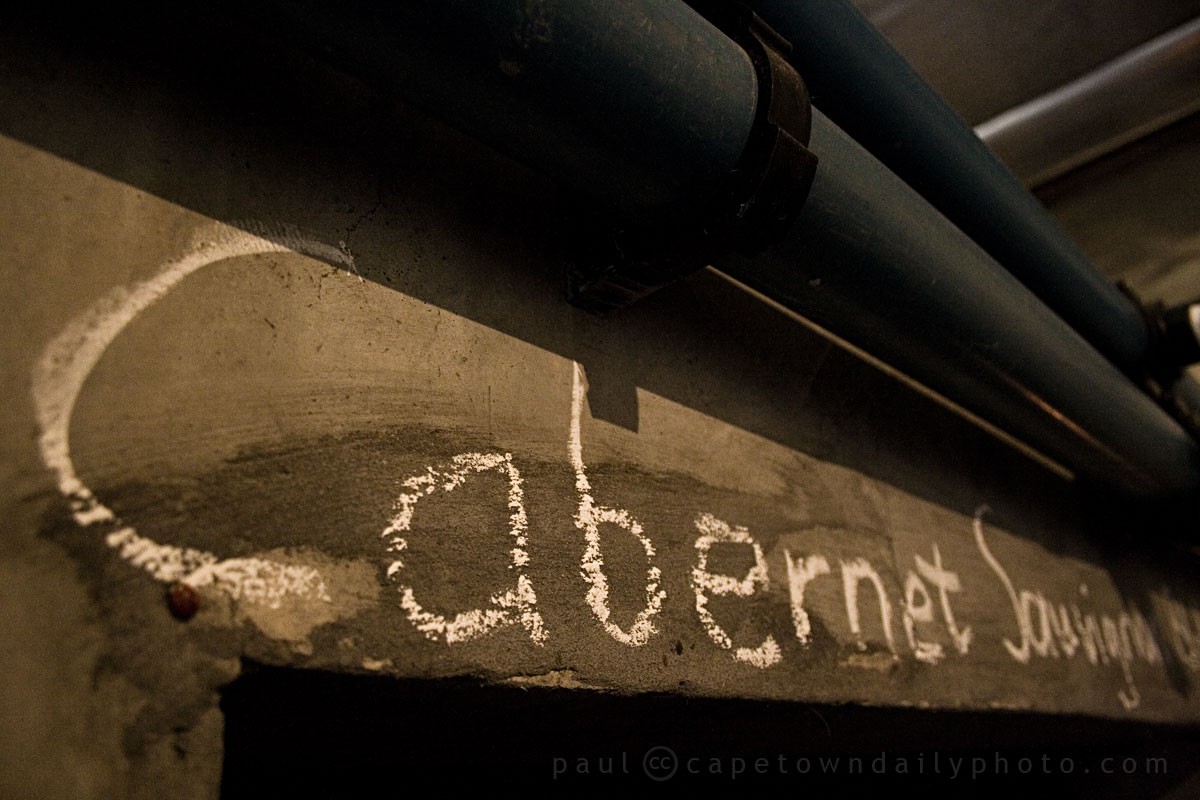The Durbanville wine route has been the subject of the last two posts, and as long as you're not getting bored, after today I have two final photos in the series.
I took this photo in the cool and damp concrete cellar of De Vallei, a boutique wine producer found along the Durbanville wine route mentioned in my first post of this series.
The subject of this photo, the words "Cabernet Sauvignon", is in fact not (as I once believed) a type of wine, but rather a type of grape. What I'm sure the wine connoisseurs among us already know is that the red Cabernet Sauvignon grape is in fact a crossing of two varieties of grape, the red Cabernet Franc and the white Sauvignon Blanc! Go figure; I guess it should have been obvious, but I had never considered this before.
So now, the question is: don't you think this should make Cabernet Sauvignon a rosé grape? ;)

mjw
I see you fixed the typos. Hee hee hee.
Pedro
dear Paul,
I appreciate your interest in wine, being a small producer, it is important for us to get more people to know about how wine is made. Especially to all of those who feel a reverential distance created by snobbysh wine amateurs, who, by the way, instead of explaining things would turn the back on you. To get back to your subject of the red white grape and related wine colour, the colour of the wine is given by pigments present in the skin of the grape, and released in time when the juice or must is in contact with such skins after being crushed. Therefore you will have white must from red grapes initially, then gradually you will acheve your final colour, depending for how long you allow the contact. You may want a rose only from red grapes, it is called blanc the noir, from french, translated into “white from red”.
The crossing of two plants and their genetic stock, would only determine the joint venture between characteristic of one plant that you want to retain to the ones of the other plant, giving you a result which is your Cab Sauv grape in this case. It has definitively got a dark red pigment in it’s skin, therefore the wines are most of the times fully fledged red wines.
I hope it helps,
cheers
pedro
Paul
Post authorHi Pedro,
Thanks for taking the time to write such a long and informative comment. I had wondered what a blanc de noir was, and what you’ve said now about the skin causing the wine to change red, in retrospect, is almost obvious.
Pedro, how are you affiliated with the Belbon Hills wine farm? I see that it’s in the Breede River Valley.
Paul
Post authormjw… typos? what typos? ;)
Pedro
Hi Paul,
as a matter of fact Belbon Hills is my wine business, I export wine I make from Breedekloof. Belbon Hills farm used to be there but due to management issues I have decided to release the cultivation of the grapes and concentrate on cellar work and marketing. At the moment I am leaning on Rico Suter’s cellar, my farm neighbour, if you happen to be in that part of the world I suggest you make an appointment with him to visit his private cellar, it is a very different environment, where you can xperience the real passion of a man who has committed all his resources, both physical and financial, to make his dream come true. It is on the R43, the Waboomsrivier turnoff and past the Breerivier road, carrying on on the gravel road. If he’s not flying his glider in Worcester he will be very happy to host a private tour and tasting. You can taste Belbon Hills wines and Rico Suter wines at once. Do not expect an extravagant tourist facility, it is a place of work, hard work, but it is worth the trip.
Regards
Pedro
Paul
Post authorThanks for the info Pedro. Perhaps it is worth while taking a drive out to your side of the Cape. :) No worries about not having “tourist facilities”. I’m sure many of our readers will agree that there’s something special about going somewhere “normal”, without the tourist-friendly facade. :)
Pingback:
An old car? | Cape Town Daily Photo